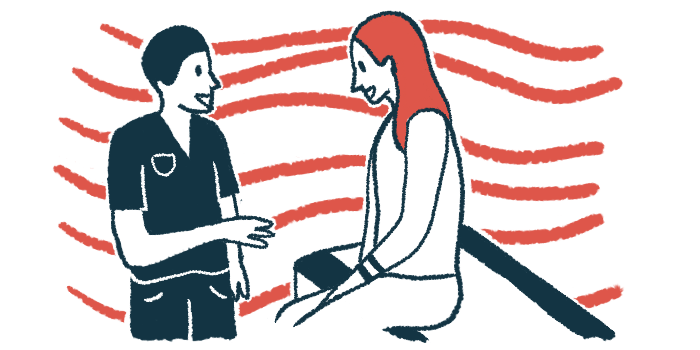MDA 2023: Evrysdi’s motor benefits found to last for 4 years in trial


Motor function is still stable or improved among people with spinal muscular atrophy (SMA) types 2 and 3 after four years of treatment with Evrysdi (risdiplam), according to updated results from the SUNFISH clinical trial.
Patients and caregivers also reported continuous improvement or stabilization in the level of help needed to perform daily life activities. In addition, side effects of the Genentech treatment — which can be administered at home — tended to decrease over the four years, the participants and their carers noted.
“These new data show that treatment with Evrysdi may help people with type 2 or 3 SMA to maintain improvements in muscle strength and mobility over the course of several years,” Levi Garraway, MD, PhD, Genentech’s chief medical officer and head of global product development, said in a company press release. Genentech is a member of the Roche group.
“The longer-term results of this study add to the robust body of findings from our broad clinical trial program evaluating Evrysdi across a variety of ages, disease severities and treatment histories,” Garraway said.
The new findings were presented at the Muscular Dystrophy Association (MDA) Clinical and Scientific Conference, in the poster, “SUNFISH Parts 1 and 2: 4-year efficacy and safety data of risdiplam in Types 2 and 3 SMA.”
Treatment side effects seen to decrease over time
SMA is a genetic condition caused by mutations in the SMN1 gene that result in little to no production of the SMN protein, needed for muscle communication. Evrysdi is an oral once-daily treatment designed to increase the production of SMN by targeting the backup gene SMN2.
The SUNFISH Phase 2/3 trial (NCT02908685) was designed to evaluate Evrysdi in children and young adults, ages 2 to 25, with SMA type 2 or 3. After a first, dose-finding part involving 51 patients, a placebo-controlled part enrolled 180 people with the disorder, all of whom could sit independently but were not able to walk.
Participants were randomly assigned to receive daily Evrysdi (120 people) or a placebo (60 people) for one year, after which they could enter an open-label extension phase in which all are receiving Evrysdi.
In the initial trial and its extension, assessments of motor function have primarily been done with Motor Function Measure-32 (MFM-32). Secondary measures of motor function include the Revised Upper Limb Module (RULM) and the Hammersmith Functional Motor Scale Expanded (HMSE).
For most patients, motor function either stabilized or improved after a year of Evrysdi, as compared with the placebo. In the main trial, findings from the MFM-32 and RULM were statistically significant, whereas the HMSE hinted at benefits but did not reach significance.
Subsequent analyses generally indicated that those stabilizations or improvements were sustained after two and three years.
Now, data presented at the MDA meeting indicate that motor function, assessed by MFM-32 and RULM, has remained generally stable over four years, with patients maintaining the improvements or stabilization in motor function they had seen in the main trial. HFMSE scores, however, have gradually declined toward pre-treatment levels.
“These latest data make us confident that the improvement observed during the first year of treatment is sustained during four years which contrasts with the decline we would observe in the absence of treatment,” said Laurent Servais, MD, PhD, a professor of pediatric neuromuscular diseases at the MDUK Oxford Neuromuscular Centre.
Preserving long-term independence and the ability to perform daily tasks is an important measure for people living with SMA and their caregivers. It’s encouraging to see that Evrysdi has meaningfully affected this aspect of their lives.
Patients and caregivers also completed the SMA Independence Scale-Upper Limb Module (SMAIS-ULM), which measures the amount of assistance required to complete daily living activities, such as self-feeding, brushing teeth, getting dressed, or writing. After four years, both patients and caregivers continued to report better scores on this scale than before starting on Evrysdi.
“Preserving long-term independence and the ability to perform daily tasks is an important measure for people living with SMA and their caregivers,” Servais said, adding, “It’s encouraging to see that Evrysdi has meaningfully affected this aspect of their lives.”
Evrysdi continued to be well-tolerated after four years, with most side effects reflective of the underlying disease, according to the company. The overall rate of side effects also decreased steadily over four years.
Common side effects included headache, fever, and upper respiratory tract infections, none of which led to study withdrawal.
In addition to SUNFISH, Roche’s clinical trial program for Evrysdi also includes FIREFISH (NCT02913482), JEWELFISH (NCT03032172), and RAINBOWFISH (NCT03779334). These studies are investigating the treatment across patients with different ages, disease severities, and treatment histories.
The Phase 2/3 trial MANATEE (NCT05115110) also is evaluating Evrysdi as part of a combination therapy with an anti-myostatin antibody designed to improve muscle growth in children and young adults with SMA. The trial is recruiting patients, ages 2-25, at sites in the U.S., Belgium, Italy, the Netherlands, Poland, and the U.K.
The post MDA 2023: Evrysdi’s motor benefits found to last for 4 years in trial appeared first on SMA News Today.


